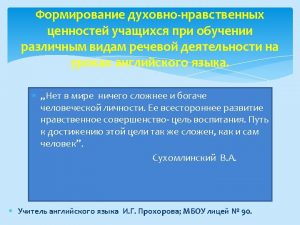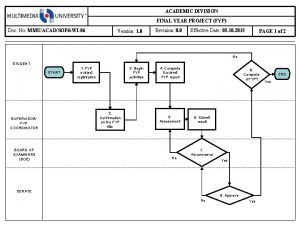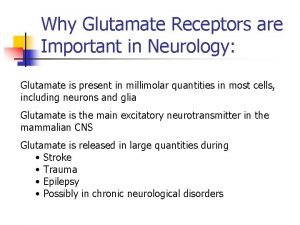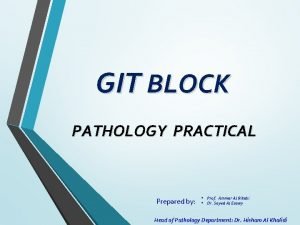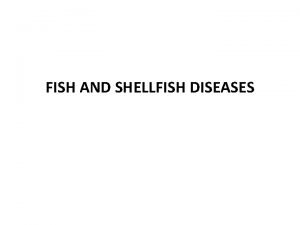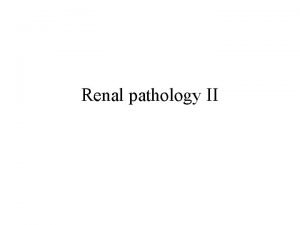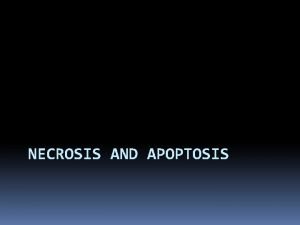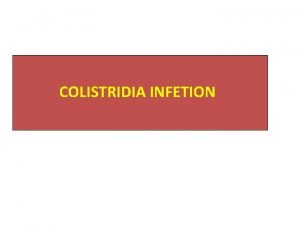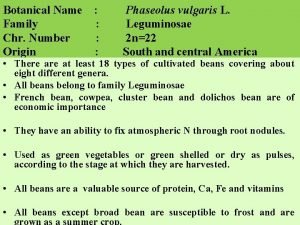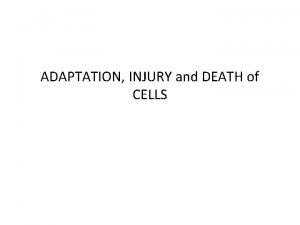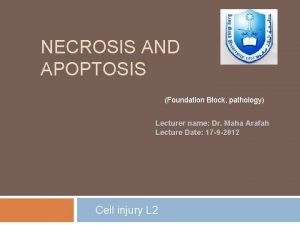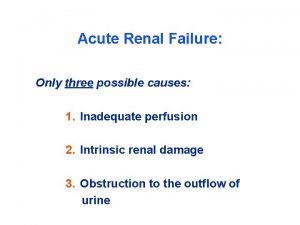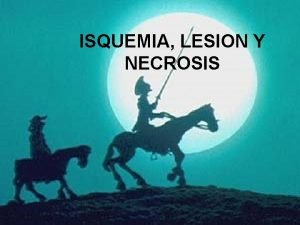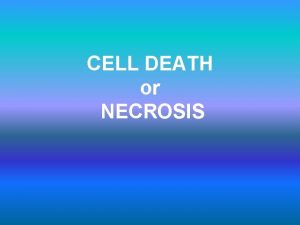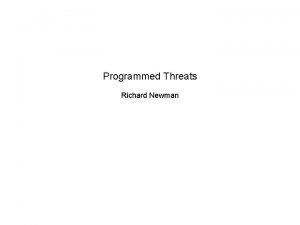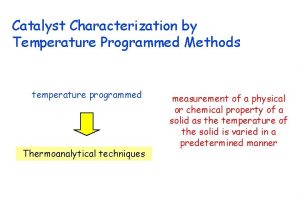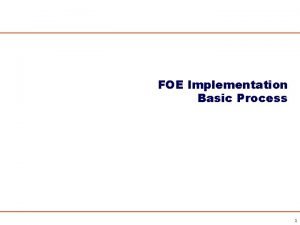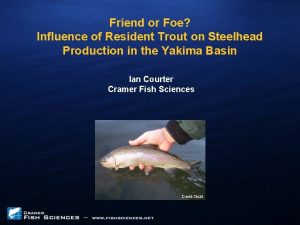Programmed Necrosis Friend Foe College of Pharmacy Keimyung












































- Slides: 44



Programmed Necrosis Friend? Foe? College of Pharmacy, Keimyung Univ. Young Sik Cho

Life or Death

Cell Responses to Stress Proliferation Differentiation Senescence What if programmed cell death might be blocked?

Apoptosis Yasuhara et al. , JHC 2003; 51: 873 -885 Necrosis Normal

APOPTOSIS VS. NECROSIS (I) Programmed Cell Death Uncontrolled, Accidental Death Naturally occurred Caused by external factor Beneficial effects Detrimental effects

APOPTOSIS VS. NECROSIS (II) Cell morphology Membrane integrity DNA Caspase activation RIP 1 requirement Immune system Apoptosis Necrosis Shrinkage Swelling Preservation Loss Fragmentation Random digestion Caspase dependent No involvement of caspase Not necessary Required No inflammatory response Significant inflammatory response

Programmed Necrosis • Extensive network of genes involved • Executed by regulated mechanism • Non-Apoptotic Cell Death • Caspase independent Cell Death • Necroptosis • Necrostatin-1, specific inhibitor of PN • Ischemic brain injury, myocardial infarction and septic shock

NECROSIS vs. PROGRAMMED NECROSIS Necro. X • Mitochondria ROS scavenger • Inhibits chemical-induced necrosis • LG 생명과학 Nec-1 • RIP 1 specific inhibitor • Protects from TNF-induced PN • Junying Yuan (HMS)

Putative Necrosis-inducing agents Nec-1

Manipulation of Cell Death Tumor Necrosis Factor alpha (TNF α) Survival CHX z. VAD Apoptosis TNF alpha Nec-1 Necrosis u 185 AA, 17 k. Da forms homotrimer u Signal transduction through binding TNF to TNFR u Pleiotropic inflammatory cytokine

TNF-mediated cell death via two sequential complex Survival D AD F 8& C- Apoptosis DD RIP 1 DD NFk. B DD DD TRAF 2 RIP 1 DD DD 1 RIP DD RIP 1 DD DD DD TRADD 2 AF TR 2 AF 1 TR RIP DD TNFR-1 DD TNF Necrosis Micheau and Tschopp, Cell, 2003

Unknown RIP 1 DD Topics for discussion P P Ø Programmed necrosis regulator Ø Physiological role of Programmed Necrosis?

Identification of RIP 3 as a hit for regulation of PN Silencing genes TNF Apoptosis PN Survival

Receptor interacting protein kinase 3 (RIPK 3) • RIP family of serine/threonine protein kinases • Unique C-terminal domain distinct from other RIP family members • Component of TNF R-I signaling complex • Induce apoptosis and weakly activate the NFk. B transcription factor

RIP 1 and RIP 3 are specifically required for PN, but not apoptosis

RIP 3 -/- MEFs are resistant to TNF-induced PN, but not apoptosis Apoptosis Necrosis

The Kinase and RHIM domains of RIP 3 are crucial for programmed necrosis

Pronecrotic complex formation under condition of PN Nec-1: Specific inhibitor of RIP 1

RIP 3 as a regulator of cell death TNFα RIP 1 RIP 3 P Apoptosis RIP 1 RIP 3 P Programmed Necrosis

Role of RIP 3 for TNF-stimulated PN when caspase inactivated A B Uninfected C • WO/CHX • z. VAD surrogate VV-NS VV-TNF

RIP 3 -dependent PN & Inflammation during VV infection Fat Liver

Viral titers in tissues and survival plot of VV-infected RIP 3+/+ and RIP 3 -/- mice

Model of the role of RIP 3 -dependent PN in the innate immune defense against VV infections

Take-Home Message RIP 3 RIP 1 DD P P P Ø Receptor interacting protein-3 (RIP 3) as a regulator of programmed necrosis Ø Programmed necrosis: Innate immune response


Physiological consequences of Programmed Necrosis Diseases Host defensive machinery Stroke Heart attack Sepsis

RIP 3 as a therapeutic target?

Interface between apoptosis and programmed necrosis Galluzzi & Kromer, Cell 2008, 135: 1161 -1163

Drug development targeting pronecrotic complex RIP 3 RIP 1 DD ① RIP 1 -RIP 3 interaction P P ③ Kinase inhibtion ② Kinase inhibtion Protein substrate

Chemicals against programmed necrosis Mol Structure III IV VIII XI TNF EC 50 (µM) z. VAD Apoptosis 2. 8 - - 5. 4 3. 6 - 6. 0 - - 5. 0 2. 0 - 3. 0 - - 4. 8 2. 0 - 12. 0 - - 6. 2 0. 6 - 2. 0 0. 1 - 0. 3 1. 0 - - -: not protected

Ongoing Project Ø Chemical-induced Programmed Necrosis Ø Dissection of Programmed Necrosis Cell Host & Microbe 7, 302 -313, 2010

Chemical-Induced Necrosis Shikonin (SKN) + SKN CONT. IP : RIP 3 WB : RIP 1 IP : RIP 3 WB : RIP 3 - Nec-1 10 u. M TNF-induced PN Nec-1 50 u. M CHX IP : RIP 3 WB : RIP 1 IP : RIP 3 WB : RIP 3 - Nec-1 10 u. M Nec-1 50 u. M

Differential roles of RIP 1 and RIP 3 for programmed necrosis (B) M o m ck R m IP 1 R m IP 3 RI P 1 /m RI P 3 (A) si. RNA RIP 3 RIP 1 (C) β-actin L 929 cell line § Fibrosarcoma cell line § Caspases not activated Gene silencing

Proposed model for distinctive role s of RIP 1 and RIP 3 Caspase z. VAD RIP 1 RIP 3 DD TNFα Necrosis


Therapeutic Use of Programmed Necrosis for cancer Chemotherapy BCR-ABL positive leukemia by Gleevec (imatinib) DNA alkylating agent Photosensitising molecules Host-Microbes: To kill or To be killed Virus Intracellular bacteria Acute and Chronic Diseases Neurodegenerative disease Septic shock Pancreatitis

Summary of clinical trials for the extrinsic apoptotic pathway Christina et al. , Am J Cancer Res 2011, 1: 43 -61

Summary of clinical trials for the autophagy pathway Christina et al. , Am J Cancer Res 2011, 1: 43 -61

Harnessing Cell Death Pathways for Cancer Therapy v Boosting apoptotic sensitization to chemotherapy or radiotherapy v Harnessing alternative cell death: Drug resistance • Autophagy • Necrosis PDT

PARP activity switches the cell fate ATP Glucose NAD 2 NAD+ 2 pyruvate 2 NADH+ ADP ATP 2 Pyruvate PARP CO 2+H 2 O Proliferation Cells Alkylating agent Ionizing radiation DNA repair PARP Vegetative cells Amino acids Fatty acids Macro-molecular Oxidative synthesis Phosphorylation ATP Programmed Necrosis ATP Cell survival and DNA repair

UMASS Francis Chan David Moquin Sreerupa Challa Melissa Guildford KMU Seung Yeon Park Ji Hyun Bae

 Hello the sun is shining
Hello the sun is shining Hello my friend!
Hello my friend! Friend or foe chapter 2
Friend or foe chapter 2 Friend or foe station lab answers
Friend or foe station lab answers Friend or foe? (game show)
Friend or foe? (game show) Keimyung university dormitory fee
Keimyung university dormitory fee Lets be good friends
Lets be good friends Foaf a matic
Foaf a matic A friend in needs a friend indeed
A friend in needs a friend indeed I've found a friend oh such a friend
I've found a friend oh such a friend To foil every foe
To foil every foe Fee fie foe firm
Fee fie foe firm Statua di zeus foe
Statua di zeus foe Psyici
Psyici Foe coetzee summary
Foe coetzee summary Foe mmu
Foe mmu As cannons overcharged with double cracks
As cannons overcharged with double cracks Golden crops foe
Golden crops foe Foe joe
Foe joe Calcolatore foe
Calcolatore foe Fyp mmu
Fyp mmu Apoptosis and necrosis
Apoptosis and necrosis Necrosis
Necrosis Necrosis
Necrosis Pancreas fat necrosis
Pancreas fat necrosis Fish and shellfish pathology
Fish and shellfish pathology Acute suppurative appendicitis
Acute suppurative appendicitis Cabra
Cabra Necrosis coagulativa
Necrosis coagulativa Acute tubular necrosis
Acute tubular necrosis Projektov�� mana����r
Projektov�� mana����r Necrosis caseosa
Necrosis caseosa Frostbite with tissue necrosis
Frostbite with tissue necrosis Liquefactive necrosis
Liquefactive necrosis Necrosis del floema del cafeto
Necrosis del floema del cafeto Colistridia
Colistridia Gangrenous necrosis
Gangrenous necrosis Hypocotyl necrosis in french bean is due to
Hypocotyl necrosis in french bean is due to Liquefactive necrosis brain
Liquefactive necrosis brain Necrosis
Necrosis Necrosis
Necrosis Necrosis
Necrosis Necrosis
Necrosis Acute tubular necrosis symptoms
Acute tubular necrosis symptoms Isquemia lesion y necrosis
Isquemia lesion y necrosis








